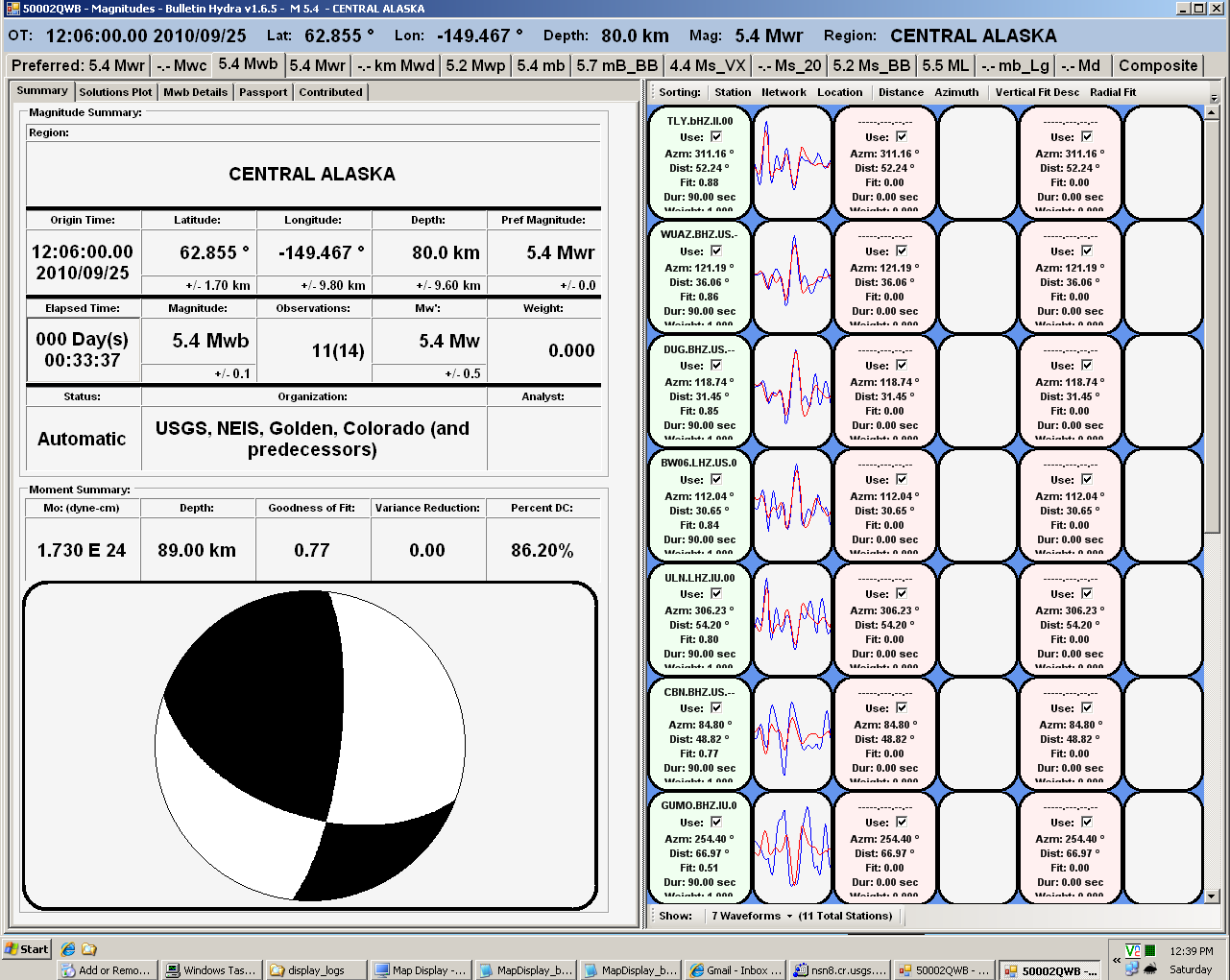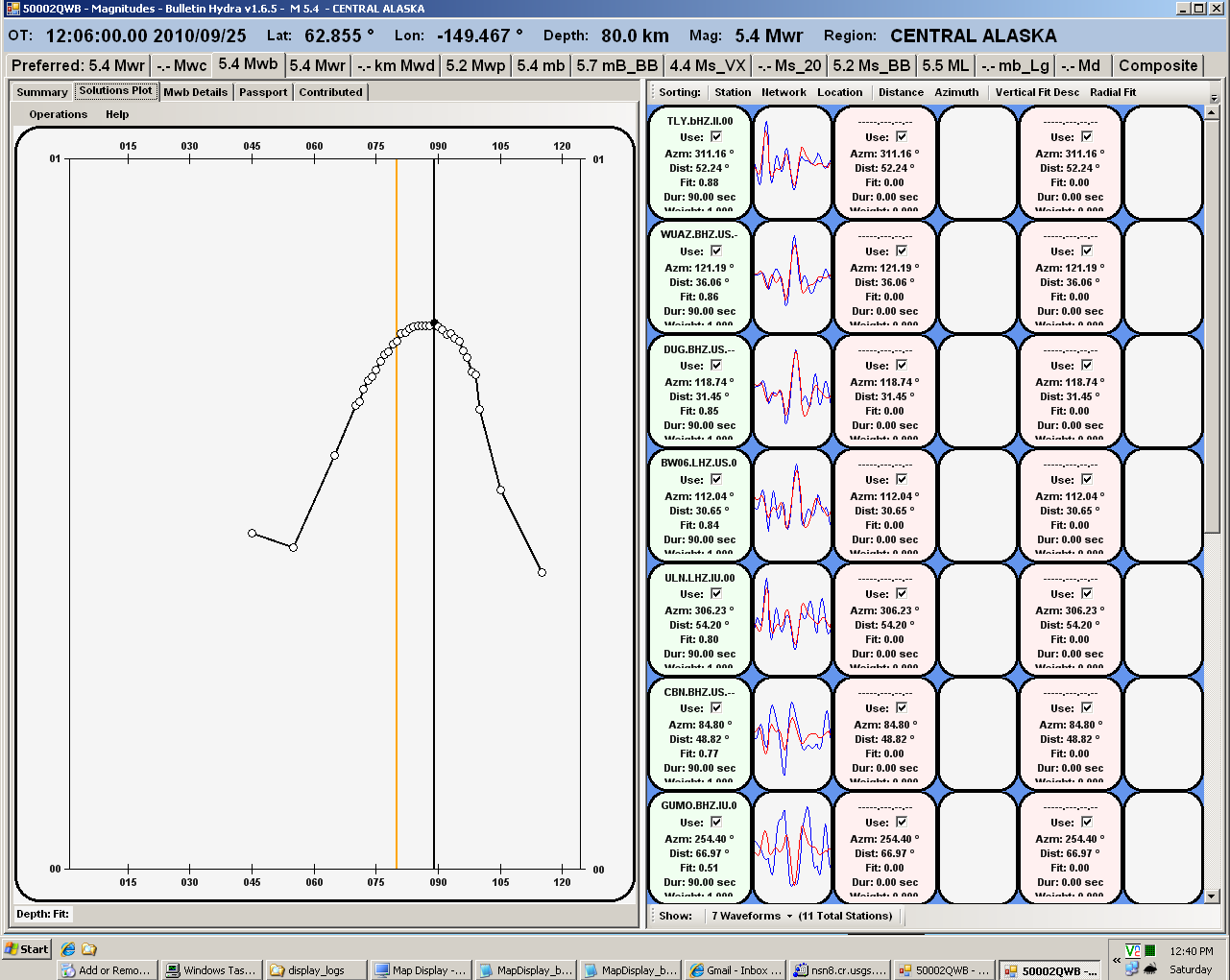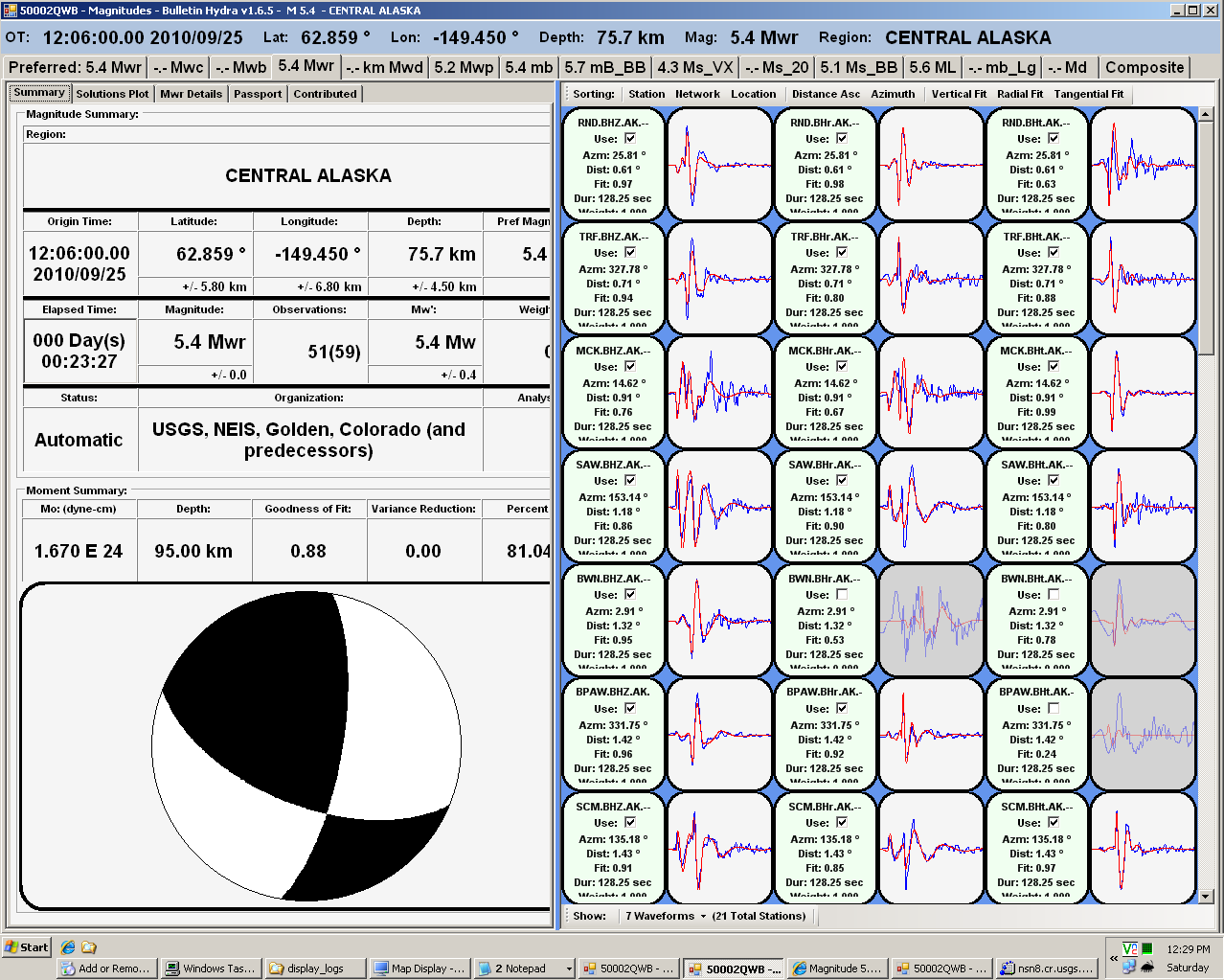Location
Location ANSS
The ANSS event ID is ak010cbf7et6 and the event page is at
https://earthquake.usgs.gov/earthquakes/eventpage/ak010cbf7et6/executive.
2010/09/25 12:06:00 62.854 -149.512 83.8 5.4 Alaska
Focal Mechanism
USGS/SLU Moment Tensor Solution
ENS 2010/09/25 12:06:00:0 62.85 -149.51 83.8 5.4 Alaska
Stations used:
AK.BMR AK.BPAW AK.BRLK AK.BWN AK.CCB AK.CHUM AK.CNP AK.DHY
AK.DIV AK.DOT AK.EYAK AK.FIB AK.GLI AK.HDA AK.KLU AK.MCK
AK.MDM AK.MLY AK.PAX AK.RC01 AK.RND AK.SAW AK.SCM AK.SKN
AK.SSN AK.TRF AK.WRH IU.COLA
Filtering commands used:
hp c 0.02 n 3
lp c 0.10 n 3
Best Fitting Double Couple
Mo = 1.43e+24 dyne-cm
Mw = 5.37
Z = 89 km
Plane Strike Dip Rake
NP1 7 69 148
NP2 110 60 25
Principal Axes:
Axis Value Plunge Azimuth
T 1.43e+24 38 326
N 0.00e+00 52 157
P -1.43e+24 5 60
Moment Tensor: (dyne-cm)
Component Value
Mxx 2.59e+23
Mxy -1.03e+24
Mxz 5.05e+23
Myy -7.82e+23
Myz -5.05e+23
Mzz 5.23e+23
##########----
###############-------
###################---------
####################----------
######## ###########-----------
######### T ############---------- P
########## ############----------
-#########################--------------
--########################--------------
----#######################---------------
------#####################---------------
-------###################----------------
----------################----------------
------------#############---------------
----------------########----------------
--------------------###-------------##
---------------------###############
--------------------##############
-----------------#############
---------------#############
-----------###########
------########
Global CMT Convention Moment Tensor:
R T P
5.23e+23 5.05e+23 5.05e+23
5.05e+23 2.59e+23 1.03e+24
5.05e+23 1.03e+24 -7.82e+23
Details of the solution is found at
http://www.eas.slu.edu/eqc/eqc_mt/MECH.NA/20100925120600/index.html
|
Preferred Solution
The preferred solution from an analysis of the surface-wave spectral amplitude radiation pattern, waveform inversion or first motion observations is
STK = 110
DIP = 60
RAKE = 25
MW = 5.37
HS = 89.0
The NDK file is 20100925120600.ndk
The waveform inversion is preferred.
Moment Tensor Comparison
The following compares this source inversion to those provided by others. The purpose is to look for major differences and also to note slight differences that might be inherent to the processing procedure. For completeness the USGS/SLU solution is repeated from above.
| SLU |
USGSMT |
USGS/SLU Moment Tensor Solution
ENS 2010/09/25 12:06:00:0 62.85 -149.51 83.8 5.4 Alaska
Stations used:
AK.BMR AK.BPAW AK.BRLK AK.BWN AK.CCB AK.CHUM AK.CNP AK.DHY
AK.DIV AK.DOT AK.EYAK AK.FIB AK.GLI AK.HDA AK.KLU AK.MCK
AK.MDM AK.MLY AK.PAX AK.RC01 AK.RND AK.SAW AK.SCM AK.SKN
AK.SSN AK.TRF AK.WRH IU.COLA
Filtering commands used:
hp c 0.02 n 3
lp c 0.10 n 3
Best Fitting Double Couple
Mo = 1.43e+24 dyne-cm
Mw = 5.37
Z = 89 km
Plane Strike Dip Rake
NP1 7 69 148
NP2 110 60 25
Principal Axes:
Axis Value Plunge Azimuth
T 1.43e+24 38 326
N 0.00e+00 52 157
P -1.43e+24 5 60
Moment Tensor: (dyne-cm)
Component Value
Mxx 2.59e+23
Mxy -1.03e+24
Mxz 5.05e+23
Myy -7.82e+23
Myz -5.05e+23
Mzz 5.23e+23
##########----
###############-------
###################---------
####################----------
######## ###########-----------
######### T ############---------- P
########## ############----------
-#########################--------------
--########################--------------
----#######################---------------
------#####################---------------
-------###################----------------
----------################----------------
------------#############---------------
----------------########----------------
--------------------###-------------##
---------------------###############
--------------------##############
-----------------#############
---------------#############
-----------###########
------########
Global CMT Convention Moment Tensor:
R T P
5.23e+23 5.05e+23 5.05e+23
5.05e+23 2.59e+23 1.03e+24
5.05e+23 1.03e+24 -7.82e+23
Details of the solution is found at
http://www.eas.slu.edu/eqc/eqc_mt/MECH.NA/20100925120600/index.html
|
USGS Body-Wave Moment Tensor Solution
10/09/25 12:06:00.00
CENTRAL ALASKA
Epicenter: 62.855 -149.467
MW 5.4
USGS MOMENT TENSOR SOLUTION
Depth 89 No. of sta: 11
Moment Tensor; Scale 10**17 Nm
Mrr= 0.53 Mtt= 0.29
Mpp=-0.82 Mrt= 0.57
Mrp= 0.87 Mtp= 1.18
Principal axes:
T Val= 1.79 Plg=38 Azm=322
N -0.12 49 168
P -1.67 13 62
Best Double Couple:Mo=1.7*10**17
NP1:Strike= 7 Dip=74 Slip= 142
NP2: 109 53 20
######-
###########------
#############--------
################---------
####### ########--------
######## T ########-------- P -
######## ########-------- -
-###################-------------
---#################-------------
----################-------------
------#############--------------
---------##########--------------
-----------#######-------------
----------------#----------####
----------------#############
-------------############
----------###########
--------#########
--#####
|

|

|

|
Magnitudes
Given the availability of digital waveforms for determination of the moment tensor, this section documents the added processing leading to mLg, if appropriate to the region, and ML by application of the respective IASPEI formulae. As a research study, the linear distance term of the IASPEI formula
for ML is adjusted to remove a linear distance trend in residuals to give a regionally defined ML. The defined ML uses horizontal component recordings, but the same procedure is applied to the vertical components since there may be some interest in vertical component ground motions. Residual plots versus distance may indicate interesting features of ground motion scaling in some distance ranges. A residual plot of the regionalized magnitude is given as a function of distance and azimuth, since data sets may transcend different wave propagation provinces.
mLg Magnitude

Left: mLg computed using the IASPEI formula. Center: mLg residuals versus epicentral distance ; the values used for the trimmed mean magnitude estimate are indicated.
Right: residuals as a function of distance and azimuth.
ML Magnitude

Left: ML computed using the IASPEI formula for Horizontal components. Center: ML residuals computed using a modified IASPEI formula that accounts for path specific attenuation; the values used for the trimmed mean are indicated. The ML relation used for each figure is given at the bottom of each plot.
Right: Residuals from new relation as a function of distance and azimuth.

Left: ML computed using the IASPEI formula for Vertical components (research). Center: ML residuals computed using a modified IASPEI formula that accounts for path specific attenuation; the values used for the trimmed mean are indicated. The ML relation used for each figure is given at the bottom of each plot.
Right: Residuals from new relation as a function of distance and azimuth.
Context
The left panel of the next figure presents the focal mechanism for this earthquake (red) in the context of other nearby events (blue) in the SLU Moment Tensor Catalog. The right panel shows the inferred direction of maximum compressive stress and the type of faulting (green is strike-slip, red is normal, blue is thrust; oblique is shown by a combination of colors). Thus context plot is useful for assessing the appropriateness of the moment tensor of this event.
Waveform Inversion using wvfgrd96
The focal mechanism was determined using broadband seismic waveforms. The location of the event (star) and the
stations used for (red) the waveform inversion are shown in the next figure.

|
|
Location of broadband stations used for waveform inversion
|
The program wvfgrd96 was used with good traces observed at short distance to determine the focal mechanism, depth and seismic moment. This technique requires a high quality signal and well determined velocity model for the Green's functions. To the extent that these are the quality data, this type of mechanism should be preferred over the radiation pattern technique which requires the separate step of defining the pressure and tension quadrants and the correct strike.
The observed and predicted traces are filtered using the following gsac commands:
hp c 0.02 n 3
lp c 0.10 n 3
The results of this grid search are as follow:
DEPTH STK DIP RAKE MW FIT
WVFGRD96 60.0 105 50 20 5.30 0.4494
WVFGRD96 61.0 105 50 20 5.30 0.4586
WVFGRD96 62.0 110 50 25 5.31 0.4669
WVFGRD96 63.0 110 50 25 5.31 0.4761
WVFGRD96 64.0 110 50 25 5.32 0.4832
WVFGRD96 65.0 110 50 25 5.32 0.4916
WVFGRD96 66.0 110 50 25 5.32 0.4980
WVFGRD96 67.0 110 50 25 5.33 0.5032
WVFGRD96 68.0 110 50 25 5.33 0.5106
WVFGRD96 69.0 110 55 25 5.33 0.5163
WVFGRD96 70.0 110 55 25 5.33 0.5214
WVFGRD96 71.0 110 55 25 5.34 0.5289
WVFGRD96 72.0 110 55 25 5.34 0.5342
WVFGRD96 73.0 110 55 25 5.34 0.5383
WVFGRD96 74.0 110 55 25 5.34 0.5430
WVFGRD96 75.0 110 55 25 5.35 0.5466
WVFGRD96 76.0 110 55 25 5.35 0.5499
WVFGRD96 77.0 110 55 25 5.35 0.5531
WVFGRD96 78.0 110 55 25 5.35 0.5554
WVFGRD96 79.0 110 55 25 5.36 0.5568
WVFGRD96 80.0 110 55 25 5.36 0.5596
WVFGRD96 81.0 110 55 20 5.36 0.5597
WVFGRD96 82.0 110 55 20 5.37 0.5618
WVFGRD96 83.0 110 60 25 5.36 0.5629
WVFGRD96 84.0 110 60 25 5.36 0.5639
WVFGRD96 85.0 110 60 25 5.36 0.5661
WVFGRD96 86.0 110 60 25 5.36 0.5656
WVFGRD96 87.0 110 60 25 5.36 0.5672
WVFGRD96 88.0 110 60 25 5.37 0.5674
WVFGRD96 89.0 110 60 25 5.37 0.5698
WVFGRD96 90.0 110 60 25 5.37 0.5657
WVFGRD96 91.0 110 60 25 5.37 0.5675
WVFGRD96 92.0 110 60 25 5.37 0.5667
WVFGRD96 93.0 110 60 25 5.37 0.5671
WVFGRD96 94.0 110 60 25 5.37 0.5669
WVFGRD96 95.0 110 60 25 5.37 0.5681
WVFGRD96 96.0 110 60 25 5.37 0.5616
WVFGRD96 97.0 110 60 25 5.37 0.5635
WVFGRD96 98.0 110 60 20 5.38 0.5617
WVFGRD96 99.0 110 60 20 5.38 0.5615
WVFGRD96 100.0 110 60 20 5.38 0.5603
WVFGRD96 101.0 110 60 20 5.39 0.5583
WVFGRD96 102.0 110 60 20 5.39 0.5555
WVFGRD96 103.0 110 60 20 5.39 0.5560
WVFGRD96 104.0 110 60 20 5.39 0.5540
WVFGRD96 105.0 110 60 20 5.39 0.5528
WVFGRD96 106.0 110 60 20 5.39 0.5498
WVFGRD96 107.0 110 60 20 5.39 0.5481
WVFGRD96 108.0 110 60 20 5.39 0.5468
WVFGRD96 109.0 110 60 20 5.39 0.5449
WVFGRD96 110.0 110 60 20 5.39 0.5431
WVFGRD96 111.0 110 60 20 5.39 0.5398
WVFGRD96 112.0 110 60 20 5.39 0.5378
WVFGRD96 113.0 110 60 20 5.39 0.5361
WVFGRD96 114.0 110 65 20 5.39 0.5351
WVFGRD96 115.0 110 65 20 5.39 0.5313
WVFGRD96 116.0 110 65 20 5.39 0.5305
WVFGRD96 117.0 110 65 20 5.39 0.5287
WVFGRD96 118.0 110 65 20 5.39 0.5263
WVFGRD96 119.0 110 65 20 5.39 0.5255
WVFGRD96 120.0 110 65 20 5.39 0.5225
WVFGRD96 121.0 110 65 20 5.39 0.5209
WVFGRD96 122.0 110 65 20 5.39 0.5191
WVFGRD96 123.0 110 65 20 5.40 0.5165
WVFGRD96 124.0 110 65 20 5.40 0.5146
WVFGRD96 125.0 110 65 20 5.40 0.5130
WVFGRD96 126.0 110 65 20 5.40 0.5099
WVFGRD96 127.0 110 65 20 5.40 0.5097
WVFGRD96 128.0 110 65 20 5.40 0.5055
WVFGRD96 129.0 110 65 20 5.40 0.5050
The best solution is
WVFGRD96 89.0 110 60 25 5.37 0.5698
The mechanism corresponding to the best fit is

|
|
Figure 1. Waveform inversion focal mechanism
|
The best fit as a function of depth is given in the following figure:

|
|
Figure 2. Depth sensitivity for waveform mechanism
|
The comparison of the observed and predicted waveforms is given in the next figure. The red traces are the observed and the blue are the predicted.
Each observed-predicted component is plotted to the same scale and peak amplitudes are indicated by the numbers to the left of each trace. A pair of numbers is given in black at the right of each predicted traces. The upper number it the time shift required for maximum correlation between the observed and predicted traces. This time shift is required because the synthetics are not computed at exactly the same distance as the observed, the velocity model used in the predictions may not be perfect and the epicentral parameters may be be off.
A positive time shift indicates that the prediction is too fast and should be delayed to match the observed trace (shift to the right in this figure). A negative value indicates that the prediction is too slow. The lower number gives the percentage of variance reduction to characterize the individual goodness of fit (100% indicates a perfect fit).
The bandpass filter used in the processing and for the display was
hp c 0.02 n 3
lp c 0.10 n 3

|
|
Figure 3. Waveform comparison for selected depth. Red: observed; Blue - predicted. The time shift with respect to the model prediction is indicated. The percent of fit is also indicated. The time scale is relative to the first trace sample.
|

|
|
Focal mechanism sensitivity at the preferred depth. The red color indicates a very good fit to the waveforms.
Each solution is plotted as a vector at a given value of strike and dip with the angle of the vector representing the rake angle, measured, with respect to the upward vertical (N) in the figure.
|
A check on the assumed source location is possible by looking at the time shifts between the observed and predicted traces. The time shifts for waveform matching arise for several reasons:
- The origin time and epicentral distance are incorrect
- The velocity model used for the inversion is incorrect
- The velocity model used to define the P-arrival time is not the
same as the velocity model used for the waveform inversion
(assuming that the initial trace alignment is based on the
P arrival time)
Assuming only a mislocation, the time shifts are fit to a functional form:
Time_shift = A + B cos Azimuth + C Sin Azimuth
The time shifts for this inversion lead to the next figure:

The derived shift in origin time and epicentral coordinates are given at the bottom of the figure.
Velocity Model
The WUS.model used for the waveform synthetic seismograms and for the surface wave eigenfunctions and dispersion is as follows
(The format is in the model96 format of Computer Programs in Seismology).
MODEL.01
Model after 8 iterations
ISOTROPIC
KGS
FLAT EARTH
1-D
CONSTANT VELOCITY
LINE08
LINE09
LINE10
LINE11
H(KM) VP(KM/S) VS(KM/S) RHO(GM/CC) QP QS ETAP ETAS FREFP FREFS
1.9000 3.4065 2.0089 2.2150 0.302E-02 0.679E-02 0.00 0.00 1.00 1.00
6.1000 5.5445 3.2953 2.6089 0.349E-02 0.784E-02 0.00 0.00 1.00 1.00
13.0000 6.2708 3.7396 2.7812 0.212E-02 0.476E-02 0.00 0.00 1.00 1.00
19.0000 6.4075 3.7680 2.8223 0.111E-02 0.249E-02 0.00 0.00 1.00 1.00
0.0000 7.9000 4.6200 3.2760 0.164E-10 0.370E-10 0.00 0.00 1.00 1.00
Last Changed Sat Apr 27 01:53:17 PM CDT 2024












